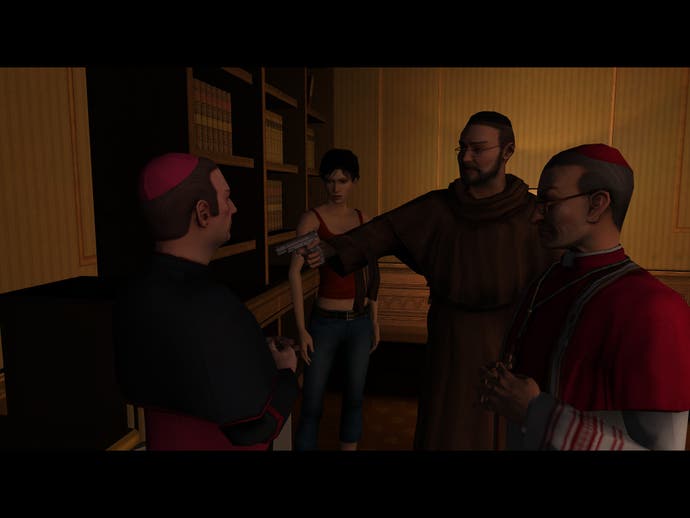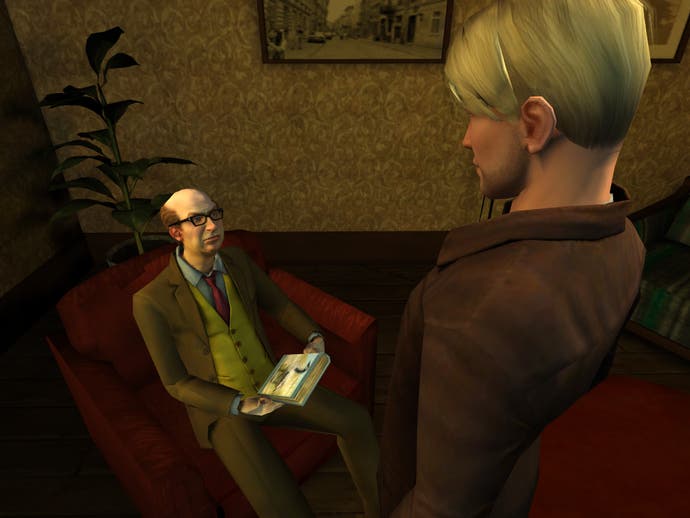Broken Sword: The Angel of Death
Too pure.
There's something so defiantly old school about Revolution's latest that you want to hug it like an old security blanket. With Broken Sword: The Angel of Death, Charles Cecil and co have done exactly what we've been asking them to do for the past six years or so: get back to basics. They've stopped trying to make hopeless concessions to action games. They've stopped listening to the naysayers who claim the adventure game is dead. And best of all, they've convinced publisher THQ to let them made a game that's all about the puzzles and the narrative. Want action? Go and buy an action game; there's plenty of them out there.
By going back to where the series started, Revolution is set free to create a twisted web of puzzles that require the kind of attention to detail and lateral thought that many gamers will be unfamiliar with these days. If your idea of a puzzle is pulling a lever, pushing a crate into a pressure pad or finding a key for a locked door, then leave via the nearest exit. The Angel of Death requires you to actually pay attention to your inventory, to repeatedly grill characters for new information, to approach puzzles logically and, above all, be persistent. This isn't a game that delivers a quick fix, but one that administers entertainment in long, lingering doses, punctuated by the occasional burst of incredulity.
Once again, religious conspiracy forms the centrepiece of a fiercely twisting narrative that has become the series' trademark. This time it centres on an ancient weapon that Moses once unleashed upon the Egyptians to devastating effect, and is in danger of being rediscovered and utilised by fanatical Catholics. The ever-hapless George Stobbart finds himself unwittingly caught up in the whole sorry mess - yet at the start of the game we find the blonde-haired fop somewhat down on his luck. Set a year after the controversial events of the Glastonbury incident in The Sleeping Dragon, Stobbart's reputation is in tatters and he's forced to take a job at a Big Bro's Bail Bond company and bore people about his amazing extendible golf club.
Nun shall pass
Enter Anna Maria - a dubiously proportioned blonde who's on the run from Mafia types who want to get their hands on some kind of ancient manuscript. Striking up an instant, enduring and frequently flirtatious partnership, you spend much of the game trying to sneak her past security guards and generally figuring out ancient riddles. And then the game turns on its head several times as you begin to doubt the motives of practically everyone you meet - as well as your own sanity on some of the trickier puzzles you come across on your journeys.

Initially, the most surprising aspect of the game is just how stripped down the interface is. Although you can still take direct control of the player's movements, it soon becomes apparent that point and click is by far the most intuitive means of getting around. Click anywhere on the screen and George moves there. Hover the mouse over an item of interest and click on it. It's point and click in the purest sense, with possibly the cleanest adventure interface possible. As usual, the cursor changes dynamically - depending on the context - to an eyeball to examine, a cog to activate, or a hand icon to pick something up, and you're never in doubt of the limitations of what you're allowed to interact with. Hover it over an unlocked door and it'll change to an open door icon, move the cursor it changes to a speech icon, and so on.
In the instances where there are multiple choices, right clicking over the object brings up all available actions, with a further left click to confirm. With the inventory tucked out of sight at the top of the screen, ,moving the cursor up brings up an icon bar with everything you're carrying displayed in icon form. Simply click on an object you want to use, move it out of the inventory, and click again on the object/person you want to use it on. Easy. Occasionally you might want to further examine items you've picked up, or combine objects within the inventory, and sometimes you'll want to talk to people to gather clues by clicking on them and any icons that appear in the simplified conversation system at the bottom of the screen. If you've played either of the first two Broken Sword games, you'll be right at home, because The Angel of Death plays almost exactly like them in every respect.
Moving on, heading back

The main difference, of course, is that graphical technology has moved on massively since those old classic 2D adventures. The Sleeping Dragon proved that a move to 3D could retain all the old visual charm of the 96/97 vintage, and The Angel of Death brings it even closer to the original's style - albeit with all the old control mechanics restored. Whether viewed at 1280x1024 on your PC monitor, or at 1360x768 on your big wide-screen HDTV, the game looks sumptuous throughout. The slightly elongated-looking characters fit perfectly into the Broken Sword design mould, complete with somewhat exaggerated walking animations that seem to fit somehow. And although the dynamically shifting camera angles are superbly unobtrusive for the most part, Revolution and Sumo haven't quite nailed lip syncing yet, sadly, despite doing a much better job of mastering facial expressions this time around. Apart from a few other minor niggles (mainly with climbing stairs, and a few odd hair rendering glitches) it's technically the best in the series. Certainly, in terms of locations, fans of the series will be delighted - not just with their consistent high quality, but how self-contained each part of the game is.
With all the basics of the game so completely and utterly nailed, what remains is to judge it on the quality of the puzzles and narrative. Taking the last point first (because we're cowards), it's definitely a cut above The Sleeping Dragon in every sense. The whole plot line is consistently engaging in a way we haven't felt about an adventure for, ooh, years. Although the characters are still very much in the traditional 'archetypal' mould that resonates throughout the entire series, the voice acting is about ten times better than tiresomely stereotypical Sleeping Dragon. Stobbart is as typically understated, bumbling and wry as ever, and all the various supporting cast do a fine job even when cast in their roles as archetypal Irish, Scot, English, Turk, Mafioso and so on. Maybe the script's just a little better this time, too, because the EG cringeometer never once twitched. On the whole, it's just a damned good yarn, and by the end you feel like you've even learned a little, too - which is a rarity in videogaming.


